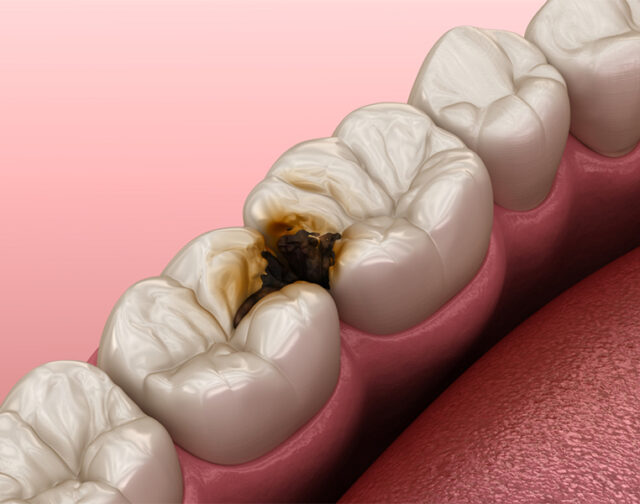 Dental caries, commonly known as tooth decay or cavities, is a prevalent dental issue that can lead to significant damage to the hard surfaces of teeth, often resulting in cavity formation. In this article, we will delve into the causes of dental caries, strategies for prevention, signs that indicate the need for treatment, and the various treatment options available.
Dental caries, commonly known as tooth decay or cavities, is a prevalent dental issue that can lead to significant damage to the hard surfaces of teeth, often resulting in cavity formation. In this article, we will delve into the causes of dental caries, strategies for prevention, signs that indicate the need for treatment, and the various treatment options available.
- Why Does Dental Caries Occur? Get solution from the best dentists in vizag for best Dental Caries Treatment at Indu’s Dental Specialities
Dental caries can manifest due to a variety of factors:
- Poor Oral Hygiene: Incorrect brushing techniques and inadequate oral care contribute to the formation of cavities.
- Tooth Misalignment: Malaligned teeth can create brushing challenges, making some areas more susceptible to decay.
- Diet Choices: Consuming sticky or acidic foods and beverages can erode tooth enamel.
- Stomach Acids: Conditions that lead to gastric acid reflux can weaken tooth enamel.
- High Carbohydrate Intake: Diets rich in carbohydrates and sugary foods can fuel cavity development.
- Tooth Anatomy: Deep pits and fissures in tooth surfaces can trap food particles and bacteria.
- Saliva Consistency: Thick, sticky saliva may not provide adequate protection against decay.
- Genetics: Inadequate fluoride uptake due to genetic factors can increase vulnerability.
- Aging: Gum recession with age can expose tooth surfaces to food debris and bacteria.
- Health Conditions: Conditions like diabetes, radiation therapy, and gastrointestinal problems can impact oral health.
- Frequent Snacking: Repeated snacking or sipping sugary drinks throughout the day can increase the risk.
- Bedtime Infant Feeding: Putting a child to bed with a bottle containing sugary liquids can contribute to early childhood caries.
- Prevention Strategies: Know more about best Dental Caries Treatment in vizag
To prevent dental caries, consider the following measures:
- Brushing with Fluoride Toothpaste: Regularly brush your teeth after eating or drinking to remove food particles and bacteria.
- Rinse Your Mouth: After every meal, rinse your mouth with water or an alcohol-free mouthwash to reduce acidity.
- Regular Dental Visits: Schedule routine dental check-ups to detect and address issues early.
- Dental Sealants: Consider sealants for deep fissures on tooth surfaces to prevent food and bacteria accumulation.
- Limit Snacking and Sipping: Reduce the frequency of snacking and sipping sugary beverages between meals.
- Fluoride Treatments: Opt for fluoride treatments to restore tooth enamel in the early stages of decay.
- Anti-Bacterial Treatments: Your dentist may recommend anti-bacterial treatments to combat bacteria that contribute to decay.
- Signs That Indicate the Need for Treatment:Visit the best dental hospital in vizag for best Dental Caries Treatment.
Seek dental care if you experience any of the following symptoms:
- Black or Brown Stains on Teeth: Discoloration can indicate the presence of decay.
- Food Lodgement: If you frequently have food stuck between your teeth.
- Pain: Toothaches or discomfort while eating or drinking.
- Tooth Abscess: Pus discharge from the gums around a tooth.
- Swelling: Intraoral or extraoral swelling, especially near the affected tooth.
- Fractured Tooth Surface: Visible cracks or chips on the tooth surface.
- Teeth Shifting: Changes in the positioning of your teeth.
- Cavity Formation: Actual holes or pits in your teeth.
- Sensitivity: Increased sensitivity to hot, cold, sweets, or food.
- Bleeding from Teeth: Gums that bleed during brushing or flossing.
- Treatment Options: Book your appointment now at the best dental clinic in vizag
The treatment for dental caries depends on the severity of the condition:
- Fluoride Treatments: Effective for early-stage decay, fluoride treatments help restore tooth enamel.
- Fillings: In cases where decay affects enamel and dentin, the decayed portion is removed and replaced with materials like composite or amalgam.
- Indirect Pulp Capping: Used for decay near the pulp, this procedure involves placing a temporary restoration and monitoring it for symptoms.
- Root Canal Treatment: When decay reaches the pulp, the infected tissue is removed, and the tooth is restored with gutta-percha, followed by crown placement.
- Crowns: For severely damaged or brittle teeth, crowns are placed to protect them from further harm.
- Extractions: Irreparably damaged teeth or broken fragments are extracted under local anesthesia.
Conclusion:
Dental caries can have a significant impact on oral health, but with proper prevention and timely treatment, the effects can be mitigated. Regular dental check-ups and adopting good oral hygiene practices are key to maintaining healthy, cavity-free teeth. If you suspect dental caries or require treatment, consult your [Best Dentist for Dental Caries in Visakhapatnam] for expert care and guidance. Remember, a healthy smile begins with proactive dental care.
Book your appointment Now at Indu’s Dental Clinic with the best dentist in Vizag, providing the Best Dental treatments in Visakhapatnam for all your Dental needs
Visit www.indudental.in (or) call +91- 888 631 4525 for hassle-free dental treatments.
Also Follow us on Instagram and Facebook to access tips, events, and a gallery of our success stories.
